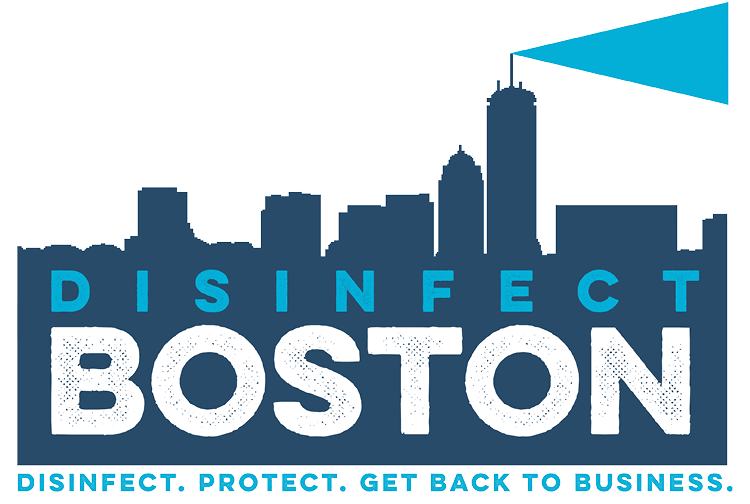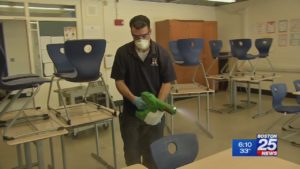MORE
ABOUT
Electrostatic Spray Technology
How Do We Clean for this Virus?
We provide comprehensive Electrostatic Disinfection with EPA and FDA approved cleaning solutions designed to kill germs, viruses, influenza and including strains of COVID. An innovative new surface treatment system that combines proven electrostatic technology with trusted EPA approved products to quickly and easily provide superior coverage in even the hardest-to-reach places. Using patented electrostatic technology to optimize product delivery, the Disinfect Boston process is a cost-effective solution for efficient, comprehensive surface treatment that is designed to help keep facilities healthier while saving them time, money, and labor.
EPA studies (EPA-600-R-15-279 and USEPA 2015b) show that compared to traditional sprayer systems, an electrostatic spray technology is more efficient, reduces waste, and delivers a more uniform distribution of liquids over uneven surfaces.
• Applies chemicals faster
• Uses less solution
• More complete and consistent coverage
• Takes 65% less time to disinfect compared to conventional methods
• Improves infection control and the spread of viruses such as influenza, MRSA, HIV, and many others
• Prevents costly financial burdens associated with contagious healthcare infections


Specialized Products
The CDC recommends usage of a labeled hospital-grade disinfectant with claims against similar pathogens to the virus. While there is currently no product tested against this particular strain of the virus, we are following all guidelines as provided by the CDC and local authorities.
- We use CDC approved and EPA registered industrial-strength disinfectants with a broad spectrum kill claim.
- All infected materials are cleaned, disinfected, and properly disposed of as biohazard waste All our technicians wear personal protective equipment (PPE) and respirator masks are always worn by our certified cleanup technicians.
- We adhere to a stringent virus demobilization process for our equipment, trucks and waste storage areas.
Disease outbreak is an extremely serious situation and we understand that the health and safety of you, your family, and employees are on the line. Do not take any chances; call in the professionals.
CDC Recommendations
The CDC encourages cleaning of high-touch surfaces such as counters, tabletops, doorknobs, light switches, bathroom fixtures, toilets, phones, keyboards, tablets and tables. Other spaces mentioned in the CDC’s guidance for commercial spaces include:
Kitchen/Food Areas
Bathrooms
Schools/Classrooms
Offices
Retail Spaces
Water Fountains
Shelving/Racks
Sales Counters
Carpets and Rugs
Stair Handrails
Elevator Cars
Playground Equipment
Fitness Equipment
Types of Facilities We Disinfect and Sanitize:
Commercial Buildings
Gas Stations
Bars
Office Buildings
Hotels & Motels
Apartments
Schools
Warehouses
Apartments
Schools
Warehouses
When You Are Ready to Open Your Doors
Once your business is up and running again and your staff has returned to work, it is important to keep in mind that a regular audit of your new policies and regulations needs to be done. Assess what is working, what is not, and what is being adhered to. The Virus situation itself is being reassessed continuously, relaxing restrictions does not mean we will not re-enter another period of lock down. It is still a time of caution for all of us.
Why not use Disinfect Boston’s professional Electrostatic Disinfection cleaning services before reopening your business and ensure your workplace is hygienic and safe for all employees?
When it comes to virus disinfection, it is better to be safe than sorry.
Call 617-984-5222 and schedule a virtual or on-site consultation with one of our Professional Electrostatic Disinfection Services Technicians.
How Do We Clean for this Virus?
Most surface areas are neutral (uncharged) or negative. Electrostatic application for surface disinfection is a method of applying disinfectants to a target surface area by utilizing electrostatic force of attraction. Simply put, the electrostatic system places an electrical charge on the droplets and disperses them across a target surface area, providing a comprehensive, even coverage.
This provides a consistent and uniform coverage in which the droplets adhere to vertical, horizontal and three-dimensional surfaces (“wraps” around the target area). As proven in the agriculture and automotive industries, this electrostatic application process takes less time to achieve the desired effect, while substantially reducing chemical costs. (Laryea and No, 2004 and 2005; Matthews, 1992)
Research has shown that microorganisms can survive on surfaces for days, weeks, and even months, and can be hidden from current spray and wipe methods. (Kramer, 2006) Using electrostatic technology provides effective, proven, safe and comprehensive surface coverage and eliminates cross contamination of dangerous pathogens. Regarding COVID-19, the virus can last on surfaces for several hours, or even days.
Virus-Clean: Electrostatic Sprayers, Used Around The World
Electrostatics is a branch of physics that studies the phenomena and properties of stationary or slow-moving electric charges (Electrostatics, 2016). Electrostatic phenomena is easily demonstrated when lint is attracted to clothes, or when dust clings to a TV screen.
Electrostatic induction charging is a method of creating or generating static electricity in a material by bringing an electrically charged object near it. This causes electrical charges to be redistributed in the material, resulting in one side having an excess of either positive (+) or negative (-) charges.
With these technological advances, we are saving people’s live around the world. We are continuing to keep up on trends to provide the best possible cleaning solutions in the future.
EPA Approved : Features of Electrostatic Spraying
EPA studies (EPA-600-R-15-279 and USEPA 2015b) show that compared to traditional sprayer systems, an electrostatic spray technology is more efficient, reduces waste, and delivers a more uniform distribution of liquids over uneven surfaces.
• Applies chemicals faster
• Uses less solution
• More complete and consistent coverage
• Takes 65% less time to disinfect compared to conventional methods
• Improves infection control and the spread of viruses such as influenza, MRSA, HIV, and many others
• Prevents costly financial burdens associated with contagious healthcare infections
We recommend the EPA’s list of disinfectants for use against SARS-CoV-2, the cause of this Virus. The list can be reviewed here.

